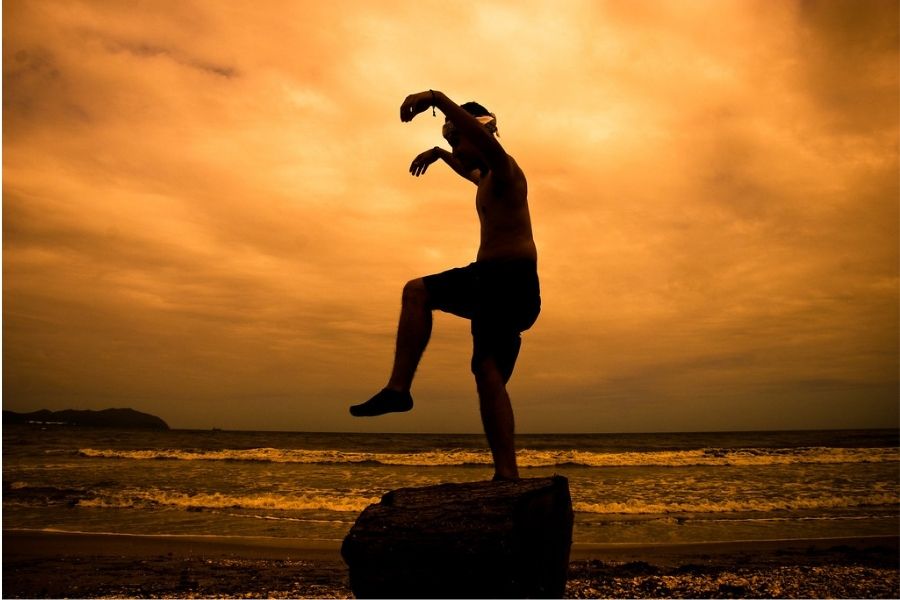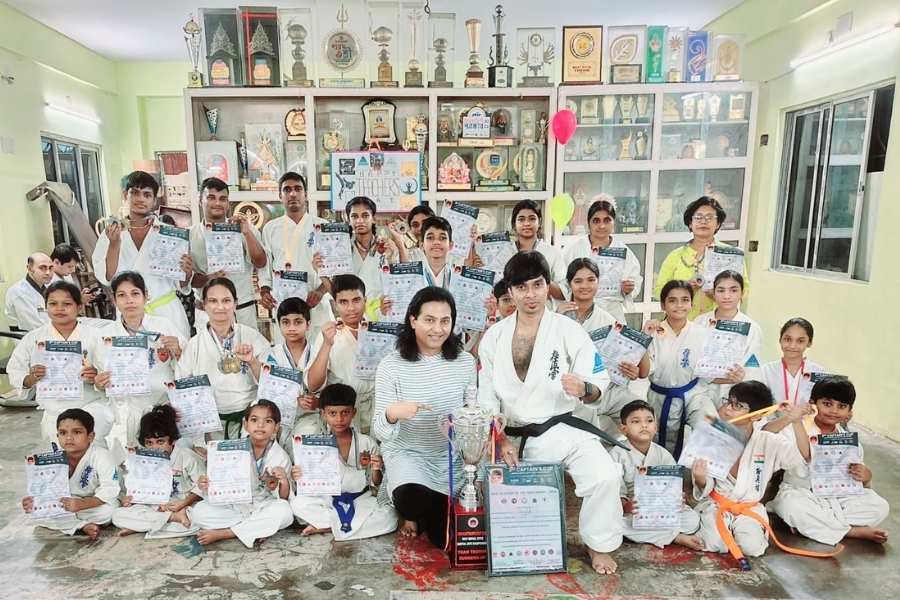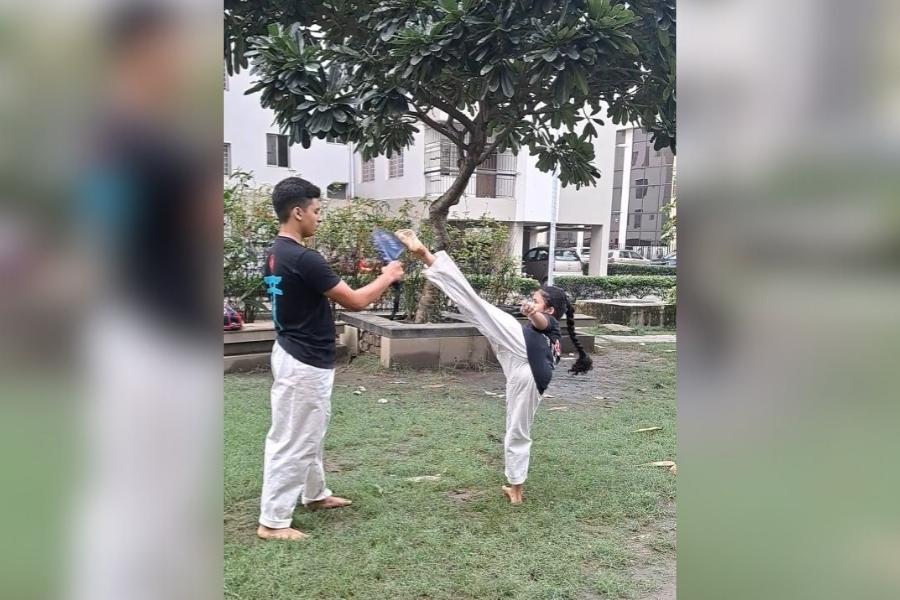Back in 1984, Daniel LaRusso pulled off a surprise, knocking out Johnny Lawrence with a crane kick in the movie Karate Kid — the first in a series of films and shows that followed. But that kick, an iconic moment in the history of martial arts films, did much more than garner cheers. It enthused an entire generation to take up karate as a sport.
Cut to 2025, the bustling neighbourhoods of Kolkata are witnessing a karate revolution — clad in crisp white karate gi, kids bow to their senseis in nondescript dojos and commit to practice the combat sport with sincerity, honour and pride.
“When I started in 1993, people barely knew what karate was,” says Sensei Sankhadeb Bhattacharya, the India branch chief of International Karate Alliance Kyokushin Ryu, appointed directly by the organisation's Japanese headquarters. “Back then, it was seen as a hobby. Now, it’s a necessity.”
Bhattacharya, a multi-time State & National Champion and the Flag bearer for India at the World Championships in 2017 runs dojos across Kolkata, including Ajay Sangati, New Vista Academy (Shivrampur), and others in Kalyani, north and south 24 Parganas His organization covers 18 states in India, with over 1,500 students in Kolkata alone. “From four-year-olds to 85-year-olds, karate is for anyone willing to learn,” he says.

Ralph Macchio as Daniel LaRusso in 'Karate Kid' (1984)
The three Ds that keep depression at bay
Karate is a way of life, say senseis. Concerns around safety, fitness, and confidence have led more parents to enrol their children — and themselves.
Hanshi Premjit Sen, president of the Karate Association of Bengal, began his journey in 1982. Today, he leads one of the largest networks of affiliated karate schools in the country under Shito-Ryu Seishinkai Karate-Do India, with presence from Kalimpong to the Sundarbans.
“There was a time people mocked karate—‘karati-sharati bolchish?’ they’d say. But today, we have over 8 lakh karatekas across West Bengal,” says Sen, who is also chairman of the Referee Commission of Karate India Organisation, and a certified judge with the World and Asian Karate Federations.
“Karate teaches you the three Ds—discipline, devotion, and determination. And if you have those, the fourth D—depression—never enters your life,” he adds.
One such devoted karateka is 14-year-old Bipaasha Paul, who has been practicing karate for a decade. “Karate has been my passion since I was 4,” she says. “I got my black belt when I was eight, and that shows how much I love karate. It has built confidence and helped me mentally and physically.”

Sankhadeb Bhattacharya with his students at a dojo in Kolkata
Where to train: Kolkata’s karate map
From schools like La Martiniere and Modern High to community halls in Jadavpur, Behala, and Tollygunge, karate training is accessible across Kolkata. Bhattacharya runs Auralyfe Fitness & Wellness Centrum out of multiple locations across South Kolkata. Sen runs Seishinkai Karate-Do India in Salt Lake along with academies across Kolkata, while Majumdar owns the Kyokushin Karate Dojo in Tollygunge, Golf Green and Bhowanipur.
These dojos hold classes twice a week, and often organise inter-club and open tournaments.
Sen’s karate centre alone hosts district-level championships in every region of West Bengal. “We don’t just train—we support,” he says. “Last July, we offered over ₹45 lakh in sponsorships for students participating in the South Asian Karate Championship. Some even received bonuses of ₹2 lakh for gold medals.”
Majumdar seconds Sen. “More than 20 of my students train for free. They come from families who can’t pay, but they have talent—and that’s enough. We are here to teach, not to count profits.”
Bipasha, who trains under Hanshi Premjit Sen in Salt Lake, says the support system makes a difference. “Before competitions, we train every day—morning and evening. Otherwise, I train four times a week, post school hours,” she says. “I also make time for tuition and self-study. It’s a tight schedule, but I manage.”

A girl undergoes karate training in a gated community in Kolkata
Karate as career: Sustaining livelihood and helping land jobs
Karate is also a dependable source of income in Kolkata.
“Teaching karate is a career in itself,” says Bhattacharya. “With a base of just 2,000 students, and fees averaging Rs 600 a month, you can sustain a livelihood. And that doesn’t include grading tests, uniforms, and certification—all of which are linked to Japan and validated through an ERP-based global system.”
Sen adds, “Students also get into paramilitary services like CISF and CRPF through karate quotas. Several have used their karate background to earn admission through sports quotas in top colleges.”
For Bipaasha Paul, karate is not just a part of her present—it shapes her future. She wants to go to the 2032 Brisbane Olympics. “But I also want to study engineering and maybe join the Indian Air Force. Karate has built my confidence to believe that I can do both.”
Bipaasha won two golds and a silver at the 2024 Commonwealth Karate Championship in South Africa. “I was nervous at first,” she recalls. “But watching others compete at that level motivated me. In the elite category, I won silver, and in the cadet and club categories, I won gold—including team kata with two teammates from the Karate Association of Bengal.”
Before flying to South Africa, Bipaasha competed in Malaysia at the Silent Night Championship. “That was my first international match. After that, I trained harder and my coach told me I was ready for the Commonwealth,” said Bipaasha who was honoured with The Telegraph Online Edugraph 18 Under 18 Awards 2025.

Bipaasha Paul poses with her medal at Commonwealth Karate Championship
Beyond sparring: The way of the warrior
What sets karate apart is not its kicks and katas, but its moral code. Bhattacharya’s Kyokushin curriculum, for instance, is based on the seven samurai virtues: integrity, honor, loyalty, respect, courage, honesty, and compassion.
“We teach you how to avoid a fight, not how to start one,” he says. “Karate is a last resort. The goal is to defuse, not destroy.”
Sen adds a final word of advice: “There are no shortcuts. Karate is like boiling water. If you turn off the flame, it cools down. Discipline and consistency matter.”
As someone who has grown up in Kolkata’s karate culture, Bipaasha offers her own perspective. “Yes, karate is finally coming into view. People are realising it can be a career. Earlier, many said there’s no future in karate. But now, with competitions and national recognition, that path is finally being built.”
Styles and segregations: More than belts and medals
Sports karate, traditional karate and full-contact karate are practiced in Kolkata. While sports karate follows a point-based, semi-contact approach, traditional karate emphasizes form, philosophy and controlled sparring. Full-contact karate programmes are designed for real-life combat readiness and only open for adults.
Sensei Kisholaya Majumdar, a three-time national champion and full-contact Kyokushin instructor based in South Kolkata, believes in starting slow but serious.
“You don’t hit hard from Day 1. Conditioning starts around 14 or 15, when the body is ready. But discipline begins the moment you walk into the dojo,” he explains.
Majumdar is critical of what he calls Kolkata’s “belt business”. “Too many people are belt-oriented, not knowledge-oriented. We don’t give black belts to ten-year-olds. A black belt has to be earned, not handed out for money or retention.”
From local tournaments to world championship podiums, Kolkata’s karate journey has been both steady and striking. As young students shout “osu” in synchrony, and seasoned masters bow with humility, the city’s karate culture continues to evolve—rooted in discipline, booming with opportunity, and brimming with purpose.
“Karate is not just about learning how to fight,” says Majumdar. “It’s about learning how to live.”
